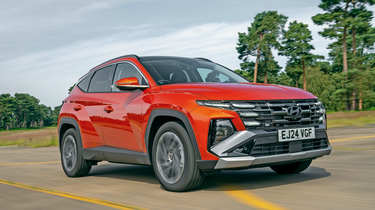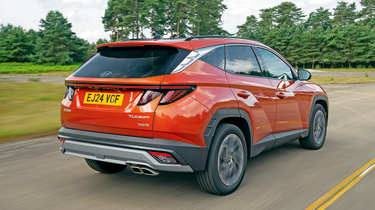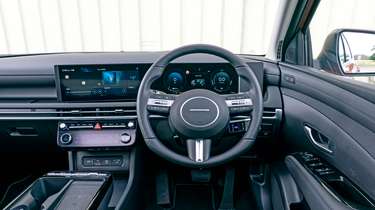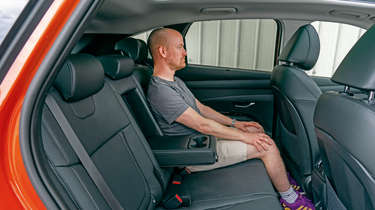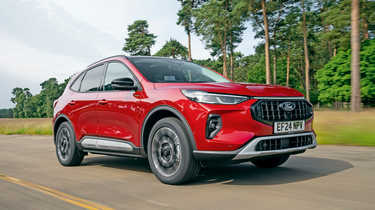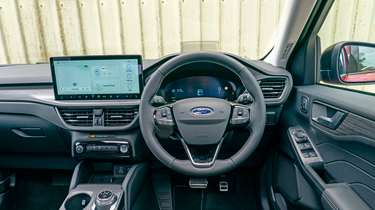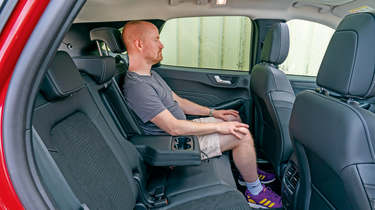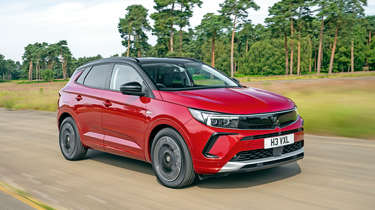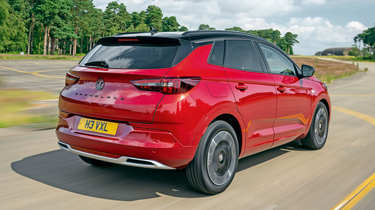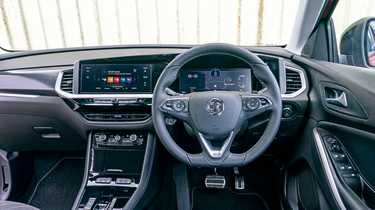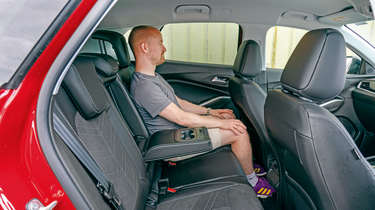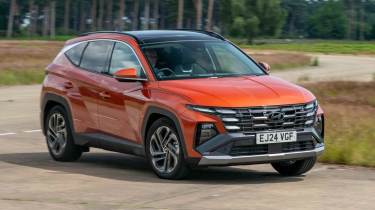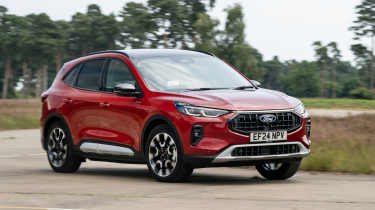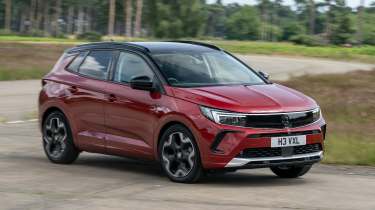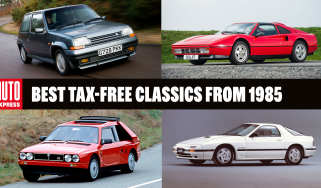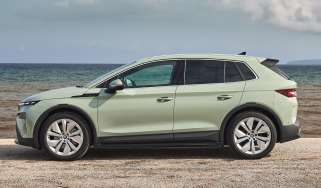Hyundai Tucson vs Ford Kuga vs Vauxhall Grandland: which is the ultimate hybrid family SUV?
Hyundai, Ford and Vauxhall go head to head to find the best hybrid family SUV on the market
In years gone by, Ford and Vauxhall dominated UK roads. The best-selling top 10 sales charts were filled almost entirely with models from both manufacturers; from Fiesta to Nova, Escort to Astra, and Sierra to Cavalier, many categories tended to have two default choices, with rivals hanging on to their coat tails.
Today, the choice in every class is wider than ever – and there are more niches to dip into for a new car – so Ford and Vauxhall have both seen their dominance wane. In the family SUV category, both have been overtaken by the Hyundai Tucson, and those numbers look set to be bolstered further, courtesy of an update for 2024.
But both of those old greats have refused to stand still. Ford has introduced a mid-life facelift for the Kuga, while the Vauxhall Grandland benefits from a new hybrid powertrain that is designed to take the car to another level. So which of our trio’s changes see it rise to the top of the heap?
Hyundai Tucson
| Model: |
Hyundai Tucson Hybrid Ultimate |
| Price: | £40,640 |
| Powertrain: |
1.6-litre 4cyl turbo HEV, 212bhp, front-wheel drive |
| 0-62mph: | 8.2 seconds |
| Test Efficiency: | 42.6mpg/9.4mpl |
| CO2: | 133g/km |
| Annual VED: | £590 |
We’re testing the high ranking versions of each of these cars – not necessarily the ones that make the most financial sense, but ones that showcase just how much tech is available in today’s family SUVs. In the case of the Hyundai Tucson, we’re trying the top-spec Ultimate model, which comes to £41,340 when you include the optional Jupiter Orange metallic paint at £700.
Tech highlights
Many of the changes to the latest Tucson are subtly cosmetic, but there are some minor revisions to the powertrain. Whether you go for mild, full, or plug-in hybrid, all versions are based around a 1.6-litre turbocharged four-cylinder petrol engine.
More reviews
Car group tests
- Volkswagen Tiguan vs Hyundai Tucson 2024 twin test: family SUVs fight it out
- Renault Austral vs Hyundai Tucson: 2023 twin test review
- Kia Sportage vs Hyundai Tucson: 2022 twin test review
- Kia Sportage PHEV vs Hyundai Tucson PHEV: 2022 plug-in hybrid SUV twin test review
In-depth reviews
Road tests
- Hyundai Tucson Hybrid 2024 review: class-leading SUV gets subtle improvements
- New Hyundai Tucson PHEV 2022 review
Used car tests
This makes 212bhp and 264Nm on its own, and in the hybrid is backed up by an electric motor that contributes 59bhp and 265Nm. Energy is drawn from a 1.49kWh battery, which allows for electric driving over short distances, including gentle acceleration and engine-off coasting. Regenerative braking can top it up on the move, and it’s possible to adjust the strength via paddles mounted behind the steering wheel.
The Tucson’s two power sources don’t produce their maximum outputs at the same time, which means that the combined output is 212bhp and 367Nm. Both front and four-wheel-drive versions are available, and it’s the former that we’re testing here. The suspension arrangement is fairly standard, with MacPherson struts at the front and a multi-link set-up at the back to accommodate 4WD.
Safety: A five-star rating was awarded to the Tucson when Euro NCAP assessed its safety in 2021. Standard tech is generous on even the base models, although only the top-spec N Line S and Ultimate models benefit from blind-spot monitoring and rear cross-traffic alert.
On the road
The Tucson’s driving experience remains familiar, so it retains the same long list of strengths as before, with just one or two minor flaws.
Around town: At low speeds the Tucson’s steering is fairly light, and when that’s combined with a low dashboard line relative to the seating position that gives a great view of the road ahead, it’s an easy car to manoeuvre at low speeds.
As with most hybrids, the electric motor takes care of driving when you move off, and the throttle response is smooth and easy to modulate, making the Tucson a calming machine in traffic.
A & B-roads: The car’s easy-going nature is maintained at higher speeds. Hyundai has set the Tucson up for stability rather than fun; the balance is neutral and predictable in corners, but the car doesn’t feel very agile.
There’s some body roll, which is fed back to the driver through precise steering that gets heavier as the tyres load up. A tiny bit of fidget aside, the ride is soft for the class average, and noises from harsher bumps and surfaces are well isolated.
The only clear area where refinement could be improved is the engine. The Tucson’s four-cylinder unit sounds rough under load, especially as the revs build. Despite there being a slight power deficit over the outgoing Tucson hybrid, there’s little difference in overall performance, and on paper the Hyundai is still the quickest car here.
Motorway: The Tucson is refined at the national limit, with little wind noise, while the solid feeling to the driving experience at low speeds translates well here. It feels very stable, and is partly helped by Crosswind Stability Control, which subtly compensates for buffeting at higher speeds.
Ownership
From the outside, the Tucson’s facelift looks fairly subtle. The brightly illuminated Close Encounters-style nose gets a subtly reprofiled grille and bumper, but it’s still impossible to mistake the Tucson for anything else. It’s a similar story at the back, where the lower portion of the bumper gets the most attention; the lights inside the moulding are a new shape, and the previous geometric pattern above the mock diffuser has been smoothed over.
It’s inside where the most significant updates have taken place – only part of the door trims and the seats remain the same as before, but the latter gain new material options. The previously monolithic look of the dashboard has been replaced with one that aligns the Tucson with the likes of the Ioniq 5. The enlarged touchscreen has been moved higher to form a gently curved panel that flows seamlessly into the digital driver’s display.
The climate controls were previously adjusted by a group of touch-sensitive buttons, but a couple of physical dials have been reintroduced, which makes it a little easier to adjust the temperature without the driver needing to divert their gaze from the road.
A five-year warranty means that should anything go wrong, the Tucson comes with an extra two years of coverage over its rivals here.
Storage: An all-new dashboard has changed some of the Tucson’s storage options. The gear selector has moved from the centre console to a column stalk, which has created more space for a new raised area ahead of the middle armrest, on which there is a relocated wireless smartphone charging pad beside a pair of deep cup-holders.
Below this section are another couple of partitioned shelves which can hold larger items. As before, the door bins are not the largest in the segment – particularly in the back, where they’re only shaped to accommodate a bottle.
Practicality
The latest round of updates leaves the Tucson’s cabin and boot dimensions unchanged. In other words, it’s still one of the most spacious cars in the class.
Rear space: The first thing you’re struck by when climbing into the back of the Tucson is just how generous rear legroom is. There’s loads of space for even tall adults to stretch out in the back, and the seats are comfortable, too. If we’re being picky, then some rivals offer a little more foot space under the front seats, and the centre seat backrest is a touch firm.
Boot: At 616 litres, there aren’t many cars in this class that come close to matching the Tucson’s cavernous boot. The load lip is fairly high – especially when compared with the Kuga’s – but at least the bumper isn’t deep. The rear seat backs drop in a 40:20:40 split, and with all three laid flat, the volume grows to 1,795 litres.
What to buy?
Which engine and trim we’d choose
- Engines: The hybrid powertrain is available with front or four-wheel drive. The latter produces the same power, but the trade-off for the extra traction is slightly slower acceleration and official fuel economy that drops by 5.1mpg.
- Trim: Buyers have five levels to choose from. The cheapest Advance starts from £35,590 – the Ultimate and identically priced N Line S cost £40,640. The Premium (£38,090) has the best blend of kit and value, with four heated seats and a heated steering wheel, an uprated stereo, adaptive cruise control, LED lights and a powered tailgate.
- Our choice: The Premium 2WD Hybrid is the sweet spot in the Tucson line-up.
Ford Kuga
| Model: |
Ford Kuga FHEV AWD Active |
| Price: | £40,865 |
| Powertrain: |
2.5-litre 4cyl HEV, 180bhp, four-wheel drive |
| 0-62mph: | 8.3 seconds |
| Test Efficiency: |
48.6mpg/10.7mpl |
| CO2: | 137g/km |
| Annual VED: | £590 |
At £40,865, the Ford Kuga is the most expensive car here, but unlike its rivals it features four-wheel drive. That price also comes before options; a range of extras brings the total price of the car you see in these pictures to £45,765.
Tech highlights
In true US style, Ford has gone for displacement over turbocharging for the Kuga’s powertrain. A naturally aspirated 2.5-litre four-cylinder petrol engine has more than double the capacity of the Vauxhall’s engine, which in theory means that it shouldn’t have to work as hard to deliver its performance – particularly because it’s backed up by an electric motor.
At 1.1kWh, the Kuga’s hybrid battery isn’t as large as the Hyundai’s, nor is the overall system quite as powerful, with a total of 180bhp sent to all four wheels. At 400Nm, it does win the contest for delivering the most torque, though.
In another nod towards maximising efficiency, the Kuga uses a CVT transmission, which enables the engine revs to rise and fall with throttle input, rather than the gear that’s selected.
Safety: Euro NCAP assessed the Kuga back in 2019, when it achieved a five-star safety rating. NCAP’s standards have since become more stringent, but Ford has moved with the times by offering more comprehensive driver-assist tech.
The updated Kuga has a revised adaptive cruise control set-up which includes what Ford calls Predictive Speed Assist. This uses navigation data to adjust the car’s speed when it approaches corners or new speed limits. In line with a 2,100kg towing capacity, Ford has given consideration to the Kuga hauling with Trailer Tow Navigation, which tries to avoid roads which could prove to be a little too tight for a large caravan or horse box.
On the road
The Kuga is the most fun to drive of this trio. If you need a family SUV that can put a smile on your face on a twisty road, then look no further.
Around town: Moving away silently on electric power makes the Kuga smooth and easy to drive at low speeds. The brake pedal doesn’t quite offer the smooth transition between electric motor regeneration and mechanical braking as in its rivals, but that aside it doesn’t feel difficult to drive.
The ride is firm by the class standards, but there’s no crashiness or harshness. Put simply, the Kuga’s chassis feels impressively sophisticated.
A & B-roads: The Active trim we’re driving here features a unique suspension tune, which jacks the front up by 10mm and the rear by 5mm when compared with the rest of the Kuga line-up. Despite that supposed high-riding nature, the Kuga is still by far the most agile, playful and enjoyable car to drive of the cars tested here.
The steering is precise and well weighted, and the nose has the grip to go where you point it. Get over the regenerative stage, and the brakes feel powerful and reassuring under foot.
Overall, the Kuga feels more like a regular family hatchback than a high-riding SUV, but keen drivers probably wouldn’t choose this hybrid version. While the petrol engine kicks in smoothly, it can sound a little strained under acceleration, particularly due to the droning nature of its CVT gearbox. It’s still more refined than the Tucson, though.
Motorway: The trade-off for fun handling is that the Kuga isn’t as capable as its rivals at long-distance cruising. Road noise in particular is more audible than in the other two competitors here, although in isolation the Ford is still relaxing enough.
Ownership
The Kuga’s facelift is fairly extensive inside and out. From the front you’re greeted by a new face; a longer bonnet extends towards a reshaped grille that’s flanked by sharper headlights. Active trim adds a stylised silver skid plate to the lower portion of the front bumper to give the impression of a rugged off-roader. At the rear there’s a smoother bumper and a more subtle hidden boot release in place of the large recessed handle that previously featured on the tailgate.
The changes inside introduce a lot more digital tech. All models now come with digital dials, with a 12.3-inch display fitted here. On the centre console, the eight-inch touchscreen has been swapped for a 13.2-inch display running Ford’s latest SYNC 4 infotainment system.
One result of this new arrangement is that the physical climate controls have been ditched in favour of on-screen controls. While they’re a permanent fixture across the bottom of the display and the keys are quite big, they’re not as intuitive as the previous set-up; as with many changes of this type, it seems like a backward step in terms of ergonomics. That aside, the Kuga’s cabin feels the cheapest here, too.
More worthy of praise is the Kuga’s fuel consumption. In our hands it returned an excellent 48.6mpg, which makes it the most efficient car in this contest, beating the Tucson by 6mpg.
Storage: Ford has kept things simple with the cubby spaces, but in general, all of the various storage spots are useful. The cup-holders are deep and have little grips to hold various sizes of drink, while the large, recessed space beneath the dashboard can hold even a bulky smartphone. Rear-seat passengers get a couple more cup-holders in the fold-down centre armrest.
Practicality
Packaging isn’t a Kuga Hybrid strong point, because much of the electrical system takes up boot space. The cabin is roomy for passengers, though.
Rear space: If you have long legs, then the Kuga’s back seats are the best place to sit in this company. Kneeroom is very impressive, and there’s also a lot of space for feet beneath the front seats. Headroom is fairly generous, too, but in shorter supply here than in either the Hyundai or Vauxhall competitors.
Boot: The hybrid system compromises the Kuga’s capacity, limiting it to just 395 litres – well behind the others here – and creating a raised level to the boot floor. However, the Ford is the only car here with a sliding rear bench; if you’re willing to sacrifice some of that rear legroom, then moving it forward increases the available space to 536 litres.
What to buy?
Which engine and trim we’d choose
- Engines: Depending on which model you choose, the Kuga offers buyers mild, full and plug-in hybrid tech. The full hybrid is offered with a choice of front or four-wheel drive – the latter is quicker thanks to extra electrical power.
- Trim: Titanium is the entry point of the Kuga range. LED lights, parking sensors and a reversing camera are standard, but it’s only available as a petrol with a manual gearbox. ST-Line has sporty styling and a 360-degree camera, while the Active gets raised suspension. Range-topping ST-Line X has a sunroof, 19-inch wheels and front and rear heated seats.
- Our choice: The ST-Line front-wheel-drive hybrid offers the best value for money.
Vauxhall Grandland
| Model: |
Vauxhall Grandland Hybrid e-DTC6 Ultimate |
| Price: | £38,335 |
| Powertrain: |
1.2-litre 3cyl turbo MHEV, 134bhp, front-wheel drive |
| 0-62mph: | 9.7 seconds |
| Test Efficiency: |
46.2mpg/10.2mpl |
| CO2: | 127g/km |
| Annual VED: | £180 |
At £38,335, the Vauxhall Grandland is the least expensive car here – at least before finance discounts are taken into account. With its optional metallic paint, the total figure rises to £39,035.
Tech highlights
Unlike the other two cars here, the Grandland’s mid-life facelift has been around for some time – it arrived in 2021. Indeed, a new model was revealed in April that rides on a platform that will accommodate a range of internal combustion and electric powertrains.
That hasn’t stopped Vauxhall from tweaking the formula for the current car, because the 1.2-litre turbocharged petrol auto model now includes 48-volt mild-hybrid power. This replaces the previous eight-speed auto with a six-speed dual-clutch gearbox that incorporates an electric motor with 28bhp and 55Nm of torque. A 0.89kWh battery is topped up through a mix of regenerative braking and engine load, and allows the Grandland to drive in EV mode for short bursts. The aim of this is to reduce emissions and deliver improved fuel economy – and on paper it delivers the goods.
Depending on trim level, the WLTP claims stand at 50.4-51.3mpg and 124-127g/km of CO2 – that’s a big jump compared with the 43.4-44.1mpg and 144-147g/km quoted for the old 1.2 auto. On paper that makes the Vauxhall the most efficient car here, even though it has the lowest level of hybrid assistance.
Safety: Vauxhall’s contender was tested by Euro NCAP back in 2017, when it was still called the Grandland X. But due to the safety body’s ever-evolving standards, its four-star rating is no longer valid. All models get traffic-sign recognition, and the top-spec Ultimate comes with adaptive cruise control and a 360-degree parking camera.
On the road
While the ride and handling are unchanged, the new hybrid system improves the Grandland’s driving experience massively.
Around town: The benefits of the Vauxhall’s petrol-electric powertrain can be felt most at low speeds. The old auto was incredibly frustrating to drive in traffic; the calibration of the brakes, gearbox and stop-start systems never synced up, which caused the car to clumsily lurch around when coming to a halt. The smooth electric motor means that feeling is completely eliminated, and as such the Grandland is much more relaxing to drive than it has ever felt previously.
A & B-roads: The Grandland finds itself in a middle ground between the Ford and Hyundai when it comes to ride and handling, but doesn’t quite manage to offer a better overall compromise than either. It feels well controlled in general and a little softer over bumps than the Ford, but it doesn’t manage to damp the noises and clunks from the suspension as effectively as either rival.
The Grandland is more agile in corners than the Tucson, but while the steering feels sharper just away from straight-ahead, that only briefly masks that the front end has less grip than either rivals’.
Motorway: High-speed refinement is decent by the standards of the class. It’s a little quieter than the Kuga at 70mph, but not quite on the Tucson’s level, thanks to a mix of road and wind noise.
The engine is the most peaceful of the three, which is fortunate because the Grandland’s power deficit means that it needs to be worked harder to reach motorway speeds. The 1.2-litre engine feels torquey at low revs, but doesn’t build as you might expect when you try to extend it further.
Ownership
Up front in the Grandland are a pair of comfortable seats that offer plenty of adjustment, including an extendable squab for more under-thigh support. The driving position itself feels more perched than the Tucson’s, but the Vauxhall’s front end slopes away more, so despite the lofty seat, it’s hard to see where the bonnet ends.
The dashboard is covered in piano-black plastic that looks modern in a brand-new test car, but we know that any model with such trim doesn’t look so fresh once a few months’ worth of fine scratches tarnish the finish. Elsewhere, there are more hard and scratchy plastics close to hand than in the Hyundai, but the Vauxhall is still a more pleasing place to sit than the Ford. The buttons and dials for the climate controls are a little smaller than the Tucson’s and are positioned low on the dash. But because every control is either a button or knob, it’s the easiest set-up to use; once you’ve learned the layout, you can make changes by feel.
At 46.2mpg, the Grandland’s hybrid system certainly proves its worth, because that figure is a big improvement on the 39.1mpg we recorded with the previous 1.2 auto during a Real-World Road Test against the Kia Sportage in June 2023. At those figures and at a petrol price of £1.45 per litre, the new hybrid would save drivers £259 every 10,000 miles compared with its predecessor.
All of these cars come with one year’s free roadside assistance from new, but an extra 12 months of cover is added to the Grandland’s package every time you take it back to a participating dealer for a scheduled service.
Storage: Cabin storage isn’t a Grandland strength. The door bins are narrow and the opening is tight under the armrest, and the bin at the base of the dash is too small for a smartphone – that’s annoying because that’s where the USB port is. Instead, devices need to live in the central armrest.
Practicality
Rear-seat space isn’t quite up with the class best, but overall space is still better than a family hatch of a similar footprint.
Rear space: Back-seat passengers won’t be quite as happy in the back of the Grandland as they are in either the Tucson or Kuga. Kneeroom and foot space are the least generous here and the seat squab is quite short. Against the tape measure, the Grandland has the best headroom, but that’s partly because the seat base is closer to the floor than in its rivals. This, along with that short squab, contributes to the least under-thigh support. On the plus side, the centre seat is soft.
Boot: A 514-litre boot isn’t a match for the vast Tucson’s, but it’s still great. When the rear seat backs are dropped (unlike the Hyundai’s, they split two ways instead of three), they don’t quite fall level and leave a small step in the load area.
What to buy?
Which engine and trim we’d choose
- Engines: The 1.2-litre turbo petrol is currently offered in three forms in the Grandland. As well as the Hybrid here, it’s still possible to buy the old auto, too. While it’s a little cheaper, the new system is worth the extra expense. If you don’t need an auto, it’s worth taking a look at the manual version – like-for-like it’s nearly £3,000 cheaper than the Hybrid.
- Trim: With the range gradually winding down ahead of the new car’s launch, at the time of writing only Ultimate trim is available to order. Standard equipment levels are excellent, though.
- Our choice: This hybrid is definitely worth the extra outlay for a smoother drive.
Results
Winner: Hyundai Tucson
The Tucson has received only minor improvements in its mid-life facelift, but they’re enough to keep it at the top of the class. Spacious, comfortable, safe and distinctive to look at, it puts ticks in so many family-car boxes, while the strong performance is a bonus, too.
Best of all, it’s very competitively priced on PCP finance deals currently, especially considering the massive list of standard kit on even the lower trim levels.
| Pros | Cons |
| Interior space | Rough engine note |
| Value for money | Average fuel economy |
Runner up: Ford Kuga
Superbly spacious for passengers and fantastic to drive, the Kuga still ranks among the class best in a few key areas. The new infotainment system is a massive step up – it’s just a shame that the physical climate buttons have gone.
Strong fuel efficiency and residuals work in its favour, but you just have to be careful when you’re going through that options list.
| Pros | Cons |
| Sharp handling | Compromised boot |
| Great fuel efficiency | Pricey options list |
Third place: Vauxhall Grandland
A replacement is due soon, but in many areas, the Grandland still holds its ground in this company. It ranks second in terms of comfort, handling, interior quality and fuel consumption, the hybrid system is impressively smooth, and standard equipment is generous.
However, it doesn’t stand out in any key area, and in terms of performance it lags behind. Harsh depreciation confines it to third here.
| Pros | Cons |
| Smooth hybrid tech | Average performance |
| Decent to drive | Hefty depreciation |
Which would you buy? Let us know in the comments section below…
Specs and prices:
| Hyundai Tucson Hybrid Ultimate | Ford Kuga FHEV AWD Active |
Vauxhall Grandland Hybrid e-DTC6 Ultimate | |
| On the road price/total as tested | £40,640/£41,340 | £40,865/£45,765 |
£38,335/£39,035 |
| Engine | 4cyl in-line HEV/1,598cc | 4cyl in-line HEV/2,488cc |
3cyl in-line MHEV/1,199cc |
| Hybrid system | 60bhp e-motor, 1.49kWh batt. | 1.1kWh battery |
28bhp e-motor, 0.89kWh batt. |
| Power | 212bhp | 180bhp | 134bhp |
| Torque | 367Nm | 400Nm | 230Nm |
| Transmission | Six-speed auto/fwd | CVT auto/4wd |
Single-speed auto/fwd |
| Fuel tank capacity | 45 litres | 54 litres | 52.5 litres |
| Length/wheelbase | 4,510/2,680mm | 4,645/2,711mm | 4,477/2,675mm |
| Height/width | 1,650/1,865mm | 1,681/1,882mm | 1,609/1,906mm |
| Boot capacity (seats up/down) | 616/1,795 litres | 395-536/1,517 litres | 514/1,682 litres |
| Kerbweight/payload/towing weight | 1,616/504/1,800kg | 1,765/550/2,100kg |
1,461/589/1,250kg |
| Turning circle/ spare wheel | 11.7 metres/option | 11.4 metres/repair kit |
10.7 metres/option |
| Basic warranty/recovery | 5yrs (unlimited)/1yr | 3yrs (60,000)/1yr |
3yrs (60,000)/3yrs |
| Driver Power manufacturer position | 17th | 28th | 24th |
| Euro NCAP: Adult/child/ped./assist/stars | 86/87/66/70/5 (2021) | 92/86/82/73/5 (2019) | NA |
| 0-62mph/top speed | 8.2 seconds/116mph | 8.3 seconds/122mph |
9.7 seconds/125mph |
| Auto Express economy/range | 42.6mpg/422 miles | 48.6mpg/577 miles |
46.2mpg/534 miles |
| WLTP combined | 47.8mpg/ 10.5mpl | 47.1mpg/10.4mpl |
50.4mpg/11.1mpl |
| Actual/Claimed CO2/tax bracket | 153/133g/km/31% | 134/137g/km/32% |
141/127g/km/30% |
| Number of airbags/Isofix points | Six/two | Six/two | Six/three |
| Parking sensors/camera | Front & rear/360 degrees | Front & rear/360 degrees |
Front & rear/360 degrees |
| Lane-keep assist/blindspot/AEB | Yes/yes/yes | Yes/yes/yes | Yes/yes/yes |
| Climate control/adaptive cruise | Three-zone/yes | Two-zone/yes | Two-zone/yes |
| Leather/heated seats/wheel | Yes/front & rear/yes | No/£550/£550* | Part/yes/no |
| Metallic paint/LED lights | £700/yes | £800/yes | £600/yes |
| Keyless entry & go/powered tailgate | Yes/yes | Yes/yes | Yes/yes |
| Sat-nav/digital dashboard/USBs | Yes/yes/four | Yes/yes/four | Yes/yes/one |
| Online services/wireless charging | Yes/yes | Yes/yes | Yes/yes |
| Apple CarPlay/Android Auto | Yes/yes | Yes/yes | Yes/yes |


